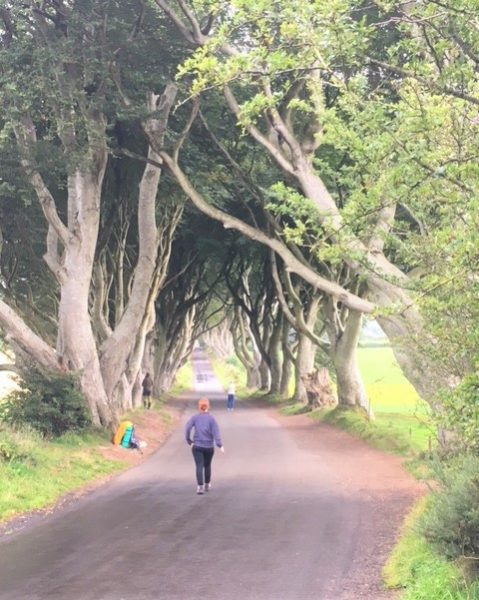Giant’s Causeway, near Bushmills north of Belfast, Northern Ireland, has an estimated 40,000 interconnected basalt towers.
The scientific cause of these massive rock formations is believed to be ancient volcanic eruptions. But leave it to the Irish to come up with a better story.

Gaelic legend has it that the formations were caused by a giant named Finn MacCool (Fionn mac Cumhaill) as a bridge to Scotland, where he planned to fight another giant named Benandonner. The two giants were said to have shouted insults at each other across the north channel of the Irish Sea. Similar rock formations are found on the Scottish coast.
Giant’s Causeway now is a major tourist attraction and tourism is an important industry in Northern Ireland, boosted by the popular HBO television series “Game of Thrones,” which is filmed there.
It’s been two decades since what Belfast locals call “The Troubles,” a period of extreme conflict and violence between Protestants and Catholics, although the two groups still live separately.

The conflict is difficult for Americans to understand – how two Christian groups can battle – but the dispute goes beyond religion and into ethnic identity.
Northern Ireland is a British foothold on the Emerald Isle. A majority of the population is Protestant and of British or Scottish descent. A minority is Irish Catholic and Catholicism is the predominant religion in the rest of Ireland. Pope Francis visited Dublin last month.
Protestants, members of Anglican or Presbyterian churches, want to keep the British connection, while Catholics would rather see Northern Island unified with the rest of Ireland.
Ciaran Smyth, our tour guide and a manager with Travel Ireland Coaches, took us around to view scenic coastline vistas, castle ruins and a few “Game of Thrones” sites.
Symth, now in his mid-30s, was 10 when he spent portions of two summers in Eden Prairie, Minn., in a program to give children from Northern Ireland – both Protestant and Catholic – a respite from the extreme violence. Smyth said the experience gave him more of an open mind to the other side.

In those days, Smyth said, it was dangerous to venture into the wrong Belfast neighborhood. Taxi drivers who went into the wrong neighborhood to pick up fares were murdered.
The violence was an outgrowth of a civil rights struggle by Catholics that began in the 1960s. At the time, Smyth said, Protestant youth could count on jobs in the shipyards, but there was no future for Catholic youth and unemployment was high.
British troops were called in to quell the protests, firing upon and killing some protesters. The U-2 song “Sunday Bloody Sunday” describes one such confrontation. Finally, after decades of struggle, the violence ebbed and a peace process began. The Good Friday Agreement of 1998, which included local political parties, England and Ireland, set up a multi-party government for Northern Ireland.

Today, the violence is over but some tensions remain. The multi-party government has not functioned in two years and civil servants run the country. Belfast still operates as two separate societies for education and business. It’s still not a good idea to venture into a bar in the wrong side of town.
Still, there have been some changes. The Gaelic language now is permitted to be taught in schools and residents can travel under either English or Irish passports.
Protestant and Catholic neighborhoods in Belfast are separated by 43 peace walls where murals are displayed, reflecting the neighborhood’s politics. Smyth’s uncle is an artist who served prison time for his role in the resistance. His murals include one dedicated to Bobby Sands, an Irish Republican Army activist who died during a hunger strike while he was imprisoned in May 1981.
Outside Belfast, the Northern Ireland coastline offers scenic vistas, stunning rock formations and green islands. We visited the Dark Hedges and the Iron Islands, two shooting locations for “Game of Thrones.” We had lunch at Wee Cottage, a tiny restaurant next to castle ruins near Bushmills.
But getting back to the giants, after Finn MacCool (English translation of the name) built his bridge, he walked across and got a glimpse of the Scottish giant, who was much bigger than him. He quickly fled back across to his Irish home and told his wife of the situation.
She had a plan. According to one version of the legend, she put a sedative in his morning beer and Finn fell asleep. She dressed her husband in a baby bonnet and gown, fashioning a giant crib to hold him.
There was a knock at the door and it was the Scottish giant, demanding to know where Finn was so the two could do battle. She said Finn was working in the fields and asked the Scotsman not to wake the baby.
As Benandonner stared into the crib, he was shocked at the baby’s size. He figured that the Irish giant must be huge to have a baby that large. The Scotsman fled back home, destroying much of the bridge along the way.
Finn jumped up from the crib to chase the Scottish giant. He scooped up some dirt and flung it. The clump of dirt landed in the middle of the Irish Sea and was said to become the Isle of Man.
Villages-News.com’s Marv Balousek recently visited Northern Ireland.

